Zeming Chen
INCLUDE: Evaluating Multilingual Language Understanding with Regional Knowledge
Nov 29, 2024



Abstract:The performance differential of large language models (LLM) between languages hinders their effective deployment in many regions, inhibiting the potential economic and societal value of generative AI tools in many communities. However, the development of functional LLMs in many languages (\ie, multilingual LLMs) is bottlenecked by the lack of high-quality evaluation resources in languages other than English. Moreover, current practices in multilingual benchmark construction often translate English resources, ignoring the regional and cultural knowledge of the environments in which multilingual systems would be used. In this work, we construct an evaluation suite of 197,243 QA pairs from local exam sources to measure the capabilities of multilingual LLMs in a variety of regional contexts. Our novel resource, INCLUDE, is a comprehensive knowledge- and reasoning-centric benchmark across 44 written languages that evaluates multilingual LLMs for performance in the actual language environments where they would be deployed.
Could ChatGPT get an Engineering Degree? Evaluating Higher Education Vulnerability to AI Assistants
Aug 07, 2024
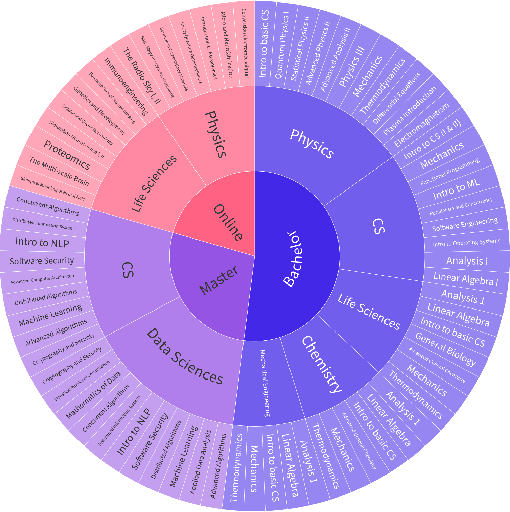
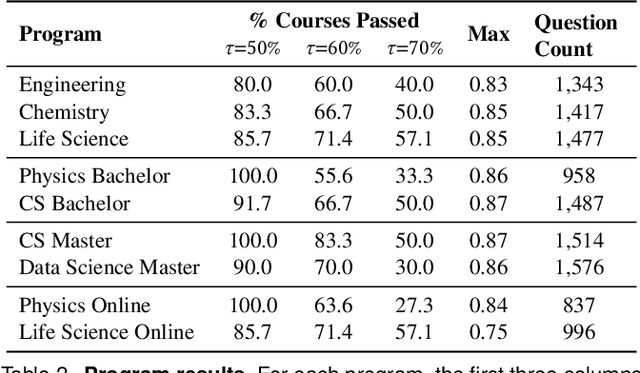

Abstract:AI assistants are being increasingly used by students enrolled in higher education institutions. While these tools provide opportunities for improved teaching and education, they also pose significant challenges for assessment and learning outcomes. We conceptualize these challenges through the lens of vulnerability, the potential for university assessments and learning outcomes to be impacted by student use of generative AI. We investigate the potential scale of this vulnerability by measuring the degree to which AI assistants can complete assessment questions in standard university-level STEM courses. Specifically, we compile a novel dataset of textual assessment questions from 50 courses at EPFL and evaluate whether two AI assistants, GPT-3.5 and GPT-4 can adequately answer these questions. We use eight prompting strategies to produce responses and find that GPT-4 answers an average of 65.8% of questions correctly, and can even produce the correct answer across at least one prompting strategy for 85.1% of questions. When grouping courses in our dataset by degree program, these systems already pass non-project assessments of large numbers of core courses in various degree programs, posing risks to higher education accreditation that will be amplified as these models improve. Our results call for revising program-level assessment design in higher education in light of advances in generative AI.
V3Det Challenge 2024 on Vast Vocabulary and Open Vocabulary Object Detection: Methods and Results
Jun 17, 2024


Abstract:Detecting objects in real-world scenes is a complex task due to various challenges, including the vast range of object categories, and potential encounters with previously unknown or unseen objects. The challenges necessitate the development of public benchmarks and challenges to advance the field of object detection. Inspired by the success of previous COCO and LVIS Challenges, we organize the V3Det Challenge 2024 in conjunction with the 4th Open World Vision Workshop: Visual Perception via Learning in an Open World (VPLOW) at CVPR 2024, Seattle, US. This challenge aims to push the boundaries of object detection research and encourage innovation in this field. The V3Det Challenge 2024 consists of two tracks: 1) Vast Vocabulary Object Detection: This track focuses on detecting objects from a large set of 13204 categories, testing the detection algorithm's ability to recognize and locate diverse objects. 2) Open Vocabulary Object Detection: This track goes a step further, requiring algorithms to detect objects from an open set of categories, including unknown objects. In the following sections, we will provide a comprehensive summary and analysis of the solutions submitted by participants. By analyzing the methods and solutions presented, we aim to inspire future research directions in vast vocabulary and open-vocabulary object detection, driving progress in this field. Challenge homepage: https://v3det.openxlab.org.cn/challenge
Complex Reasoning over Logical Queries on Commonsense Knowledge Graphs
Mar 12, 2024Abstract:Event commonsense reasoning requires the ability to reason about the relationship between events, as well as infer implicit context underlying that relationship. However, data scarcity makes it challenging for language models to learn to generate commonsense inferences for contexts and questions involving interactions between complex events. To address this demand, we present COM2 (COMplex COMmonsense), a new dataset created by sampling multi-hop logical queries (e.g., the joint effect or cause of both event A and B, or the effect of the effect of event C) from an existing commonsense knowledge graph (CSKG), and verbalizing them using handcrafted rules and large language models into multiple-choice and text generation questions. Our experiments show that language models trained on COM2 exhibit significant improvements in complex reasoning ability, resulting in enhanced zero-shot performance in both in-domain and out-of-domain tasks for question answering and generative commonsense reasoning, without expensive human annotations.
Mixed Pseudo Labels for Semi-Supervised Object Detection
Dec 12, 2023



Abstract:While the pseudo-label method has demonstrated considerable success in semi-supervised object detection tasks, this paper uncovers notable limitations within this approach. Specifically, the pseudo-label method tends to amplify the inherent strengths of the detector while accentuating its weaknesses, which is manifested in the missed detection of pseudo-labels, particularly for small and tail category objects. To overcome these challenges, this paper proposes Mixed Pseudo Labels (MixPL), consisting of Mixup and Mosaic for pseudo-labeled data, to mitigate the negative impact of missed detections and balance the model's learning across different object scales. Additionally, the model's detection performance on tail categories is improved by resampling labeled data with relevant instances. Notably, MixPL consistently improves the performance of various detectors and obtains new state-of-the-art results with Faster R-CNN, FCOS, and DINO on COCO-Standard and COCO-Full benchmarks. Furthermore, MixPL also exhibits good scalability on large models, improving DINO Swin-L by 2.5% mAP and achieving nontrivial new records (60.2% mAP) on the COCO val2017 benchmark without extra annotations.
MEDITRON-70B: Scaling Medical Pretraining for Large Language Models
Nov 27, 2023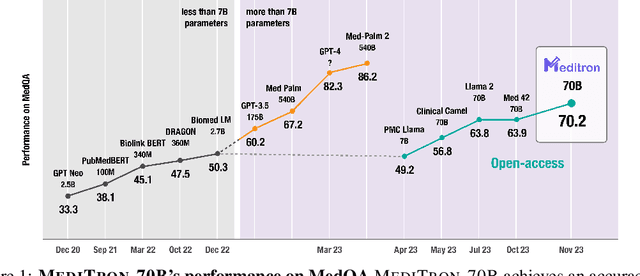
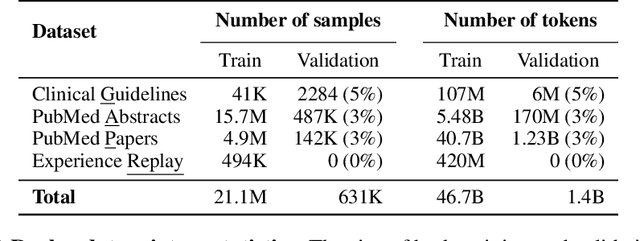
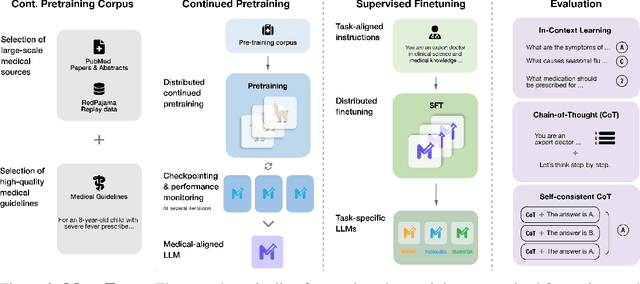
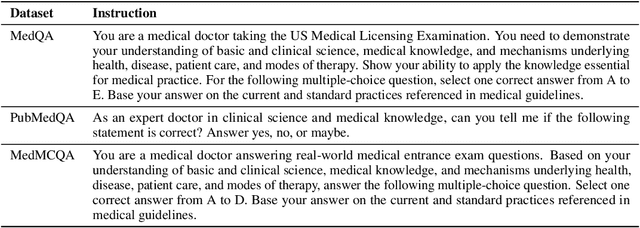
Abstract:Large language models (LLMs) can potentially democratize access to medical knowledge. While many efforts have been made to harness and improve LLMs' medical knowledge and reasoning capacities, the resulting models are either closed-source (e.g., PaLM, GPT-4) or limited in scale (<= 13B parameters), which restricts their abilities. In this work, we improve access to large-scale medical LLMs by releasing MEDITRON: a suite of open-source LLMs with 7B and 70B parameters adapted to the medical domain. MEDITRON builds on Llama-2 (through our adaptation of Nvidia's Megatron-LM distributed trainer), and extends pretraining on a comprehensively curated medical corpus, including selected PubMed articles, abstracts, and internationally-recognized medical guidelines. Evaluations using four major medical benchmarks show significant performance gains over several state-of-the-art baselines before and after task-specific finetuning. Overall, MEDITRON achieves a 6% absolute performance gain over the best public baseline in its parameter class and 3% over the strongest baseline we finetuned from Llama-2. Compared to closed-source LLMs, MEDITRON-70B outperforms GPT-3.5 and Med-PaLM and is within 5% of GPT-4 and 10% of Med-PaLM-2. We release our code for curating the medical pretraining corpus and the MEDITRON model weights to drive open-source development of more capable medical LLMs.
Discovering Knowledge-Critical Subnetworks in Pretrained Language Models
Oct 04, 2023Abstract:Pretrained language models (LMs) encode implicit representations of knowledge in their parameters. However, localizing these representations and disentangling them from each other remains an open problem. In this work, we investigate whether pretrained language models contain various knowledge-critical subnetworks: particular sparse computational subgraphs responsible for encoding specific knowledge the model has memorized. We propose a multi-objective differentiable weight masking scheme to discover these subnetworks and show that we can use them to precisely remove specific knowledge from models while minimizing adverse effects on the behavior of the original language model. We demonstrate our method on multiple GPT2 variants, uncovering highly sparse subnetworks (98%+) that are solely responsible for specific collections of relational knowledge. When these subnetworks are removed, the remaining network maintains most of its initial capacity (modeling language and other memorized relational knowledge) but struggles to express the removed knowledge, and suffers performance drops on examples needing this removed knowledge on downstream tasks after finetuning.
Mitigating Label Biases for In-context Learning
Jun 10, 2023Abstract:Various design settings for in-context learning (ICL), such as the choice and order of the in-context examples, can bias a model toward a particular prediction without being reflective of an understanding of the task. While many studies discuss these design choices, there have been few systematic investigations into categorizing them and mitigating their impact. In this work, we define a typology for three types of label biases in ICL for text classification: vanilla-label bias, context-label bias, and domain-label bias (which we conceptualize and detect for the first time). Our analysis demonstrates that prior label bias calibration methods fall short of addressing all three types of biases. Specifically, domain-label bias restricts LLMs to random-level performance on many tasks regardless of the choice of in-context examples. To mitigate the effect of these biases, we propose a simple bias calibration method that estimates a language model's label bias using random in-domain words from the task corpus. After controlling for this estimated bias when making predictions, our novel domain-context calibration significantly improves the ICL performance of GPT-J and GPT-3 on a wide range of tasks. The gain is substantial on tasks with large domain-label bias (up to 37% in Macro-F1). Furthermore, our results generalize to models with different scales, pretraining methods, and manually-designed task instructions, showing the prevalence of label biases in ICL.
RECKONING: Reasoning through Dynamic Knowledge Encoding
May 23, 2023



Abstract:Recent studies on transformer-based language models show that they can answer questions by reasoning over knowledge provided as part of the context (i.e., in-context reasoning). However, since the available knowledge is often not filtered for a particular question, in-context reasoning can be sensitive to distractor facts, additional content that is irrelevant to a question but that may be relevant for a different question (i.e., not necessarily random noise). In these situations, the model fails to distinguish the knowledge that is necessary to answer the question, leading to spurious reasoning and degraded performance. This reasoning failure contrasts with the model's apparent ability to distinguish its contextual knowledge from all the knowledge it has memorized during pre-training. Following this observation, we propose teaching the model to reason more robustly by folding the provided contextual knowledge into the model's parameters before presenting it with a question. Our method, RECKONING, is a bi-level learning algorithm that teaches language models to reason by updating their parametric knowledge through back-propagation, allowing them to then answer questions using the updated parameters. During training, the inner loop rapidly adapts a copy of the model weights to encode contextual knowledge into its parameters. In the outer loop, the model learns to use the updated weights to reproduce and answer reasoning questions about the memorized knowledge. Our experiments on two multi-hop reasoning datasets show that RECKONING's performance improves over the in-context reasoning baseline (by up to 4.5%). We also find that compared to in-context reasoning, RECKONING generalizes better to longer reasoning chains unseen during training, is more robust to distractors in the context, and is more computationally efficient when multiple questions are asked about the same knowledge.
DISCO: Distilling Phrasal Counterfactuals with Large Language Models
Dec 20, 2022Abstract:Recent methods demonstrate that data augmentation using counterfactual knowledge can teach models the causal structure of a task, leading to robust and generalizable models. However, such counterfactual data often has a limited scale and diversity if crowdsourced and is computationally expensive to extend to new perturbation types if generated using supervised methods. To address this, we introduce a new framework called DISCO for automatically generating high-quality counterfactual data at scale. DISCO engineers prompts to generate phrasal perturbations with a large general language model. Then, a task-specific teacher model filters the generation to distill high-quality counterfactual data. We show that learning with this counterfactual data yields a comparatively small student model that is 6% (absolute) more robust and generalizes 5% better across distributions than baselines on various challenging evaluations. This model is also 15% more sensitive in differentiating original and counterfactual examples, on three evaluation sets written by human workers and via human-AI collaboration.
 Add to Chrome
Add to Chrome Add to Firefox
Add to Firefox Add to Edge
Add to Edge